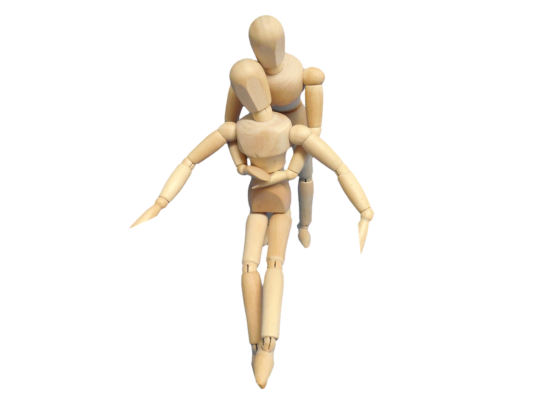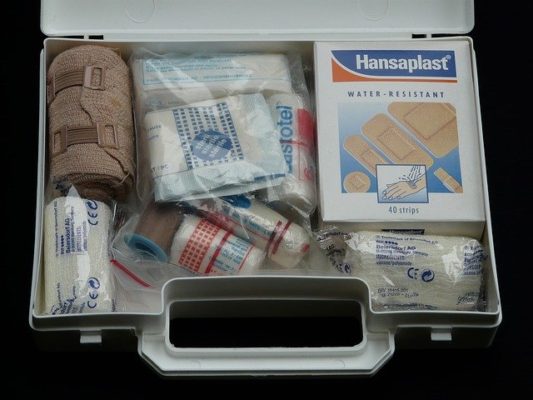Depending on your line of work, there will be specific illnesses or injuries that may be more common such as electrocution or falling. However, some common scenarios for whatever line of work you’re in come from frank accidents such as burns, bleeding, and choking. Other scenarios arise when people have medical conditions such as allergies. Knowing some basic techniques to help out in these situations can bide time until professional help arises and even save lives.
Choking
So, you’re enjoying your lunch break when your colleague suddenly clutches their throat. This terrifying situation is common and could happen to anyone, anywhere. Choking is caused by a foreign body, often food, lodging in the airway and preventing breathing. The victim will remain conscious initially but probably panic. Follow these steps to save a life.
- Keep them calm, introduce yourself if you do not know them and ask them to focus on breathing.
- Tell them to try and give 2 big coughs. Assess to see if they have coughed the blockage up.
- If not, you will need to give them back slaps.
– Stand at the victim’s side and tell them you are going to give 5 forceful slaps to the back.
– Use the heel of your hand to hit the victim between the shoulder blades in a forceful, upwards motion. - See if this has cleared the blockage. If not repeat 4 times, checking if they have coughed up the blockage after each strike.
- If this still does not work, you need to move onto abdominal thrusts – often known as the Heimlich Manoeuvre.
– Inform the victim you will be performing abdominal thrusts.
– Stand behind the victim with your arms wrapped around them.
– Make a fist with one hand and wrap the other around it with the thumbs at the top. Do not lock your fingers.
– Quickly and forcefully thrust the angle of your thumb into the centre of the abdomen just under the bottom of the breastbone in an upwards direction. - See if the victim clears the blockage after each thrust. Repeat the thrusts 4 more times.
- If this does not work, give 5 further back slaps, then 5 thrusts
- Repeat 5 slaps then 5 thrusts until the blockage clears or the patient falls unconscious.
- If the victim falls unconscious, you will need to begin CPR. To learn how, see the article on a not responding, not breathing casualty here.
If your efforts are successful, sit the casualty down and let them catch their breath. Your thrusts have saved their life, congratulations. Thrusts can be quite damaging so advise the casualty to go to A&E to be checked over by a doctor.

Allergic Reaction – Anaphylaxis
Another possibility during a lunch break is that someone will inadvertently eat something they have an allergy to. Allergic reactions vary from rashes and nausea to a very serious problem called anaphylaxis.
People in anaphylaxis have throat, tongue and lip swelling which can close their airway and make breathing impossible. It also causes a massive drop in blood pressure sending casualties into shock and potentially causing the heart to stop beating (cardiac arrest).
If you have had an anaphylactic reaction before, you should always carry two adrenaline auto-injectors, commonly known by the brand name EpiPen. Inform your colleagues of your allergy and show them how to use your EpiPen as their knowledge could save you.
- Suspect anaphylaxis if someone who has just been eating, has been near someone eating or has been near something latex-like certain protective gloves suddenly finds breathing difficult or if you notice their lips or tongue swell.
- Sit them comfortably and get them to focus on their breathing.
- Ask them if they have an adrenaline injector and if so, where they keep it. It will often be in a handbag, a jacket or coat.
- Locate the adrenaline injector and if you are unsure, read the simple instructions on the pen.
- Activate the pen by taking off the safety.
- Find the outside aspect of the victim’s thigh.
- Firmly press the side of the pen that encases the hidden needle into the outer aspect of the victim’s thigh until it clicks and hold for 5 seconds.
- This will administer adrenaline which works to open the airway and raise the blood pressure.
- The effect is short-lived so be prepared with the second injector (each pen is only 1 dose) and call 999 informing the controller you have a patient in anaphylactic shock.
- If your best efforts are unsuccessful and the patient falls unconscious, you may need to begin CPR. Check for breathing as taught in this article on the First Aid Algorithm.
Your efforts are short-term in anaphylaxis and medical attention must be sought. Call an ambulance so they can escort the victim for further management in a hospital. Well done, your actions bought enough time to save a life.

Bleeding
For the most part, bleeding comes into the Circulation part of the First Aid Algorithm which you can remind yourself of here. In rare and exceptional circumstances, major bleeds can take priority. If you work in a job which there is a risk of serious bleeds such as with heavy machinery, sharp instruments or explosives, ask your managers for formal training in first aid for major bleeds.
For more minor bleeds, ensure the casualties airway is open and they are breathing. Then move on to managing the bleed.
- Introduce yourself to the casualty and try to calm them.
- Instruct them to raise the bleeding area above the level of the heart, i.e. above chest height.
If the wound is to the leg, lie the victim down and elevate the leg on a chair or ledge. - Assess the wound to see whether it is free of debris or the item that may have inflicted the wound or whether there is gravel/glass/metal or the item that inflicted the wound left in.
- DO NOT REMOVE OBJECTS FROM THE WOUND, this may be blocking a bleed and to remove the item would make the situation much worse.
If your wound does not contain debris, follow these steps:
- Apply direct pressure to the wound with a bandage.
- If the bleeding seeps through the bandage, apply a second.
- If the bleeding seeps through the second, remove both and reapply to ensure sufficient pressure is applied to the wound.
- Continue this until the bleeding is under control.
If your wound DOES contain debris, follow these steps:
- Do not remove objects from the wound.
- Apply pressure to the wound around the object with a bandage.
- If the bleeding seeps through, apply a second bandage around the object.
- If the bleeding seeps through, remove both bandages and reapply to ensure sufficient pressure is applied around the wound.

Burns
Burns take multiple forms. The most common are thermal – from a flame or hot water. If you work in an environment around electricity or chemicals, speak to your line manager about formal training in electrical or chemical burns.
For thermal burns, remove the heat source as soon as possible, taking care to not burn yourself. Run the burnt area under clean, cold water for a minimum of 10 minutes to prevent further damage from residual heat. Once sufficiently cooled, place layers of clean clingfilm over the area. Do not wrap the arm in clingfilm as the burnt tissue may expand from the damage and the clingfilm can restrict this.
Need More Help with Basic First Aid?
ActiveHSE provides many publications and resources on Health and Safety, including basic first aid articles and training that can be tailored to your business. If you need any advice or guidance on which ones you need, don’t hesitate to get in touch.
info@activehse.co.uk | 07921 278986
Further resources:
